Southwestern Willow Flycatcher (Empidonax traillii extimus) Surveys at the City of Carlsbad Preserve, San Diego County, California—2022 Data Summary
Links
- Document: Report (3 MB pdf) , HTML , XML
- Download citation as: RIS | Dublin Core
Acknowledgments
This study was funded by the Center for Natural Lands Management.
The authors would like to thank Kathleen Balazs at the Center for Natural Lands Management for her assistance with the surveys.
Executive Summary
We surveyed for Southwestern Willow Flycatchers (Empidonax traillii extimus; flycatcher) at five survey areas within the City of Carlsbad Preserve, Carlsbad, California, in 2022. Three flycatcher surveys were completed between May 18 and June 29, 2022. Territorial or transient flycatchers were not observed at the City of Carlsbad Preserve in 2022.
Introduction
The Southwestern Willow Flycatcher (Empidonax traillii extimus; flycatcher) is one of four subspecies of Willow Flycatcher in the United States, with a breeding range that includes southern California, Arizona, New Mexico, extreme southern parts of Nevada and Utah, and western Texas (Hubbard, 1987; Unitt, 1987). Restricted to riparian habitat for breeding, the flycatcher has declined in recent decades in response to widespread habitat loss throughout its range and, possibly, brood parasitism by cowbirds (Wheelock, 1912; Willett, 1912, 1933; Grinnell and Miller, 1944; Remson, 1978; Garrett and Dunn, 1981; Unitt, 1984, 1987; Gaines, 1988; Schlorff, 1990; Whitfield and Sogge, 1999). By 1993, the species was believed to number about 70 pairs in California (U.S. Fish and Wildlife Service, 1993) in small, disjunct populations. The flycatcher was listed as endangered by the State of California in 1992 and by the U.S. Fish and Wildlife Service (USFWS) in 1995.
Flycatchers in southern California co-occur with the Least Bell’s Vireo (Vireo bellii pusillus; vireo), another riparian obligate endangered by habitat loss and cowbird parasitism. However, unlike the vireo, which has increased tenfold since the mid-1980s in response to management alleviating threats (U.S. Fish and Wildlife Service, 2006), flycatcher numbers have remained low. Currently, most flycatchers in California are concentrated at one site, the upper San Luis Rey River at Lake Henshaw in San Diego County (Howell and Kus, 2022). Outside of this site, flycatchers occur as small, isolated populations of one to six pairs.
Male flycatchers begin arriving in southern California in early to mid-May, whereas females arrive about 1-week later. While on the breeding grounds, males sing repeatedly from exposed perches. Once the pair bond is established, the female builds an open cup nest that is usually placed in a branch fork of a willow (Salix spp.) or a plant with a similar branching structure about 1–3 meters (m) above the ground. Adults usually depart from their breeding territory in mid-August and early September to their wintering grounds in Central America and northern South America.
Flycatcher breeding habitat is characterized as patches of dense riparian vegetation along rivers and streams, interspersed with small openings, open water, or areas of sparse vegetation. Vegetation species composition varies across the range, but most breeding habitats include tree or shrub cover that is at least 3 m tall, with patches of dense vegetation within 3–4 m of the ground. In addition, flycatchers typically nest near areas of standing water or saturated soil (Sogge and Marshall, 2000; U.S. Fish and Wildlife Service, 2002; Sogge and others, 2010).
Purpose and Scope
The purpose of this report is to summarize the results of flycatcher surveys completed by the U.S. Geological Survey (USGS) at five survey areas within the City of Carlsbad Preserve (hereafter, “Preserve”) in San Diego County, California, in 2022. The Preserve includes 13 parcels, totaling about 243 hectares (ha), that are owned by the City of Carlsbad and managed by the Center for Natural Lands Management according to Habitat Conservation Plan guidelines (City of Carlsbad, 1999). These data will inform natural resource managers about the status of the flycatcher at the Preserve and guide modification of land-use and management practices as appropriate to ensure the species’ continued existence. This report was prepared in cooperation with the Center for Natural Lands Management; City of Carlsbad, California; and the U.S. Fish and Wildlife Service.
Methods
Surveys
We surveyed for flycatchers on five parcels within the Preserve (hereafter, “survey areas”) that supported riparian habitat: (1) Lake Calavera, (2) Municipal Golf Course, (3) Poinsettia Park, (4) Lagoon Lane, and (5) Carrillo Ranch (fig. 1). Surveys were done during the breeding season (May–June) and followed standard survey techniques for flycatchers (Sogge and others, 2010). Three surveys for flycatchers were completed throughout the study area between May 18 and June 29, 2022. Observers walked slowly through or adjacent to suitable riparian habitat, listening and searching for flycatchers, occasionally playing a recording of a flycatcher song to elicit a territorial response. Surveys typically began at sunrise and were completed by early afternoon, avoiding conditions of high winds and extreme heat that can reduce bird activity and detectability. Flycatcher surveys were completed by USGS biologist Lisa Allen under USFWS permit ESPER0004080_0.1.
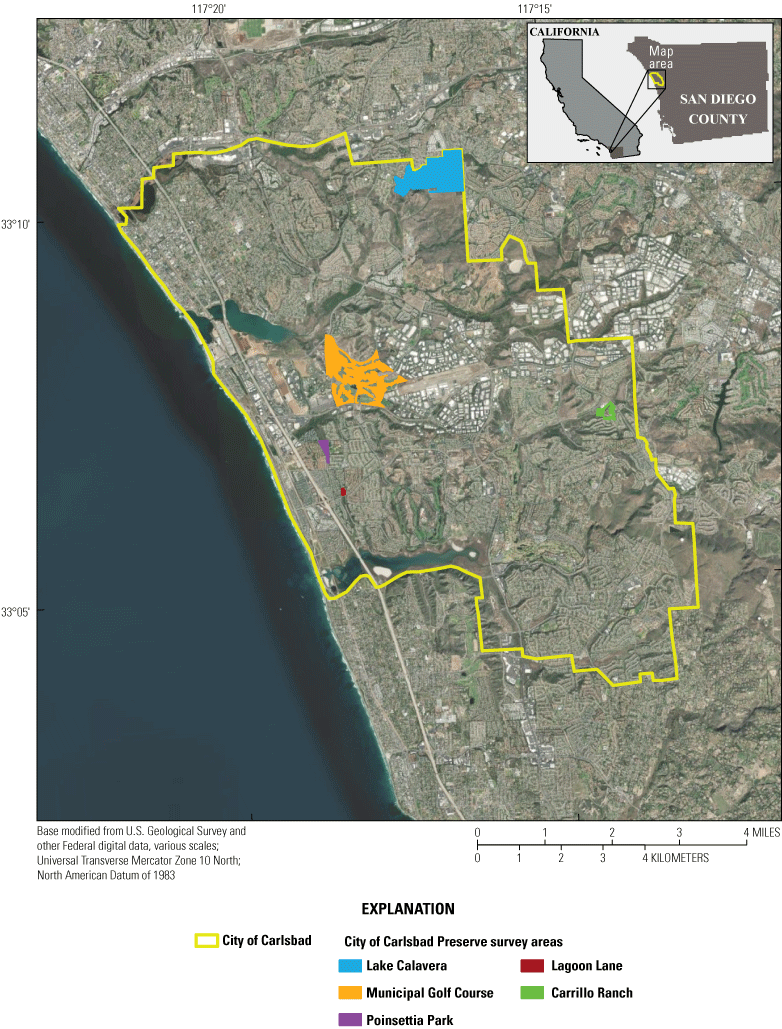
Southwestern Willow Flycatcher (Empidonax traillii extimus) survey areas at the City of Carlsbad Preserve, San Diego County, California, 2022.
-
(1) Lake Calavera: The Lake Calavera survey area is a large open-space area with a network of riparian drainages that enter into a freshwater lake (Lake Calavera; fig. 2). The survey area is bordered on the south by the Carlsbad Highland Ecological Reserve and on the north, east, and west by residential development. One main drainage in the eastern part of the survey area is dominated by southern willow scrub. Vegetation species include arroyo willow (Salix lasiolepis), Fremont cottonwood (Populus fremontii), mule fat (Baccharis salicifolia), and sandbar willow (Salix exigua). Standing water and saturated soil were present throughout the drainage. The western part of the survey area is encompassed by Lake Calavera, which is lined with freshwater marsh species, small patches of mule fat scrub, and narrow strips of willow riparian.
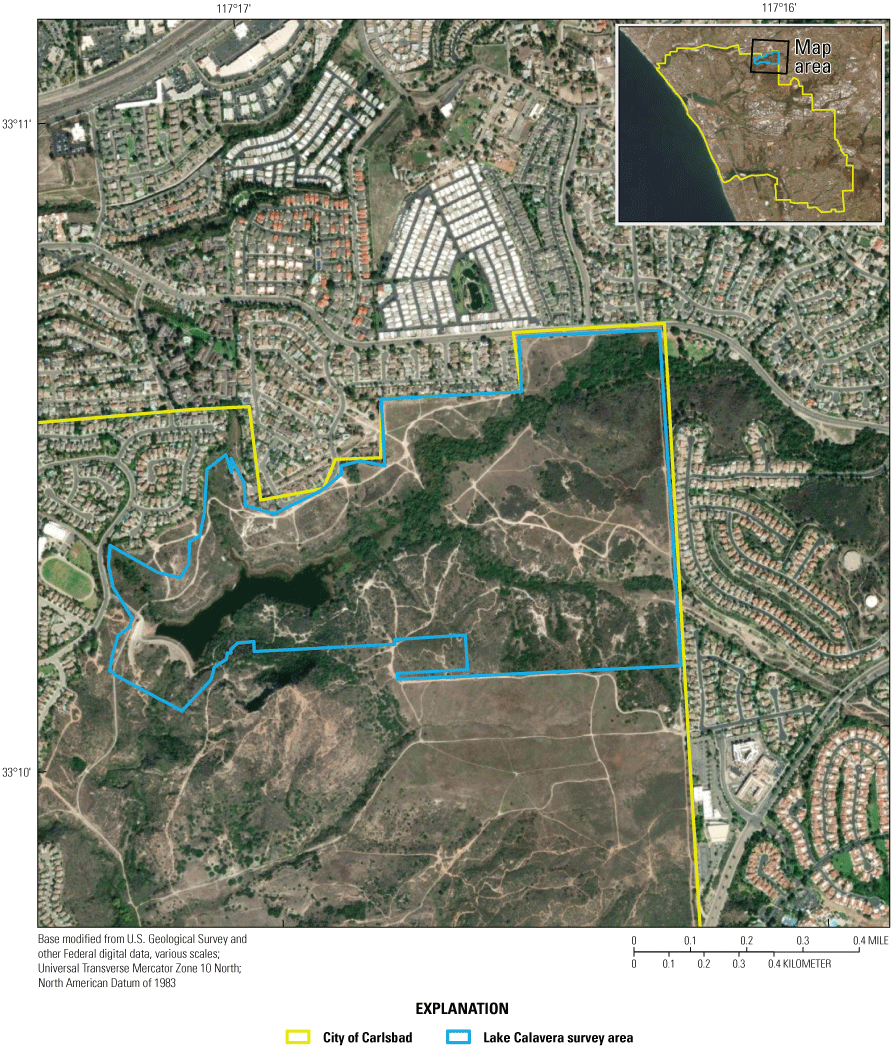
Figure 2. Southwestern Willow Flycatcher (Empidonax traillii extimus) survey area at Lake Calavera, City of Carlsbad Preserve, San Diego County, California, 2022.
-
(2) Municipal Golf Course: The Municipal Golf Course survey area is in the central part of the Preserve (fig. 3). The area surveyed includes an about 1.5 kilometer (km) long tributary of Agua Hedionda Creek, which is along the northern boundary of the Municipal Golf Course. This tributary is about 50–100 m wide, with areas of standing water and saturated soil. Vegetation includes a canopy of California sycamore (Platanus racemosa), Goodding’s black willow (Salix gooddingii), and arroyo willow, with an understory of mule fat and willow species. Outside of this tributary, riparian vegetation is scattered in small patches throughout the golf course and is comprised of mule fat and immature willows with little to no understory vegetation present.
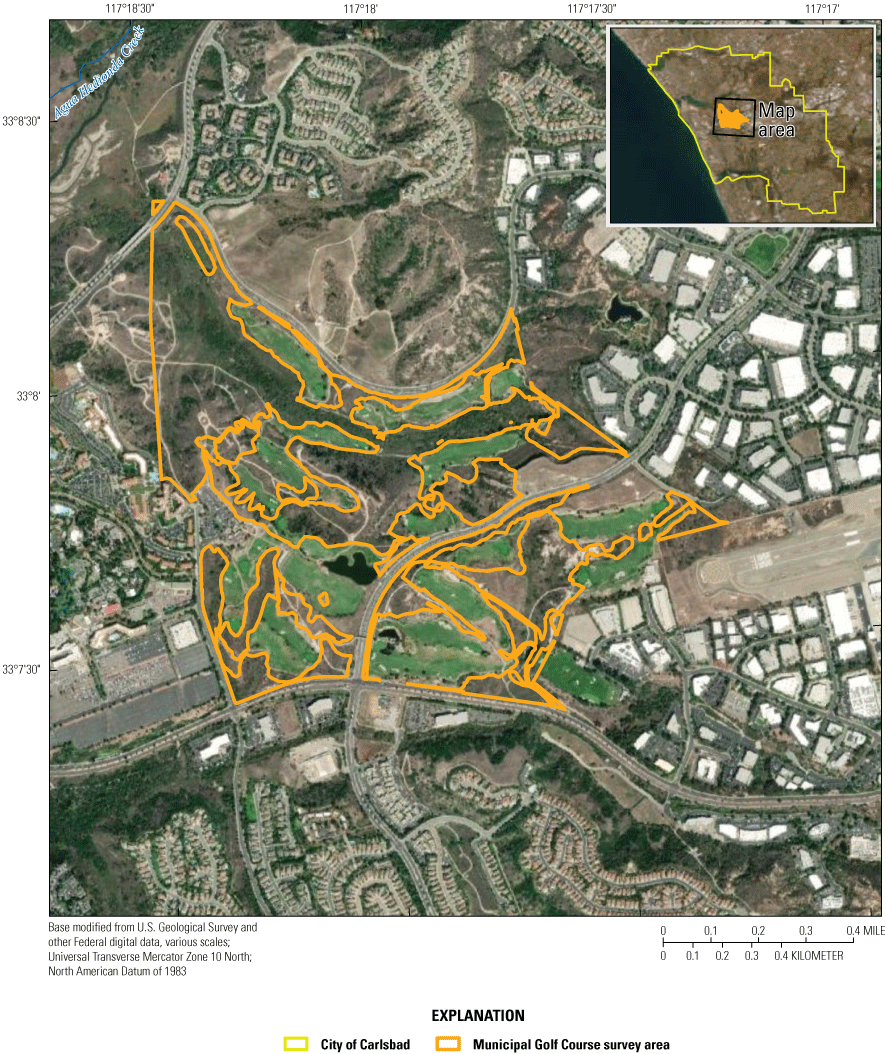
Figure 3. Southwestern Willow Flycatcher (Empidonax traillii extimus) survey area at Municipal Golf Course, City of Carlsbad Preserve, San Diego County, California, 2022.
-
(3) Poinsettia Park: The Poinsettia Park survey area is in the central part of the Preserve adjacent to Poinsettia community park (fig. 4). The riparian habitat includes a 50–75-m-wide strip along the western edge of the survey area. Vegetation species include California sycamore, coast live oak (Quercus agrifolia), and willow species, with a sparse understory of mule fat, coyote brush (Baccharis pilularis), and willow species.
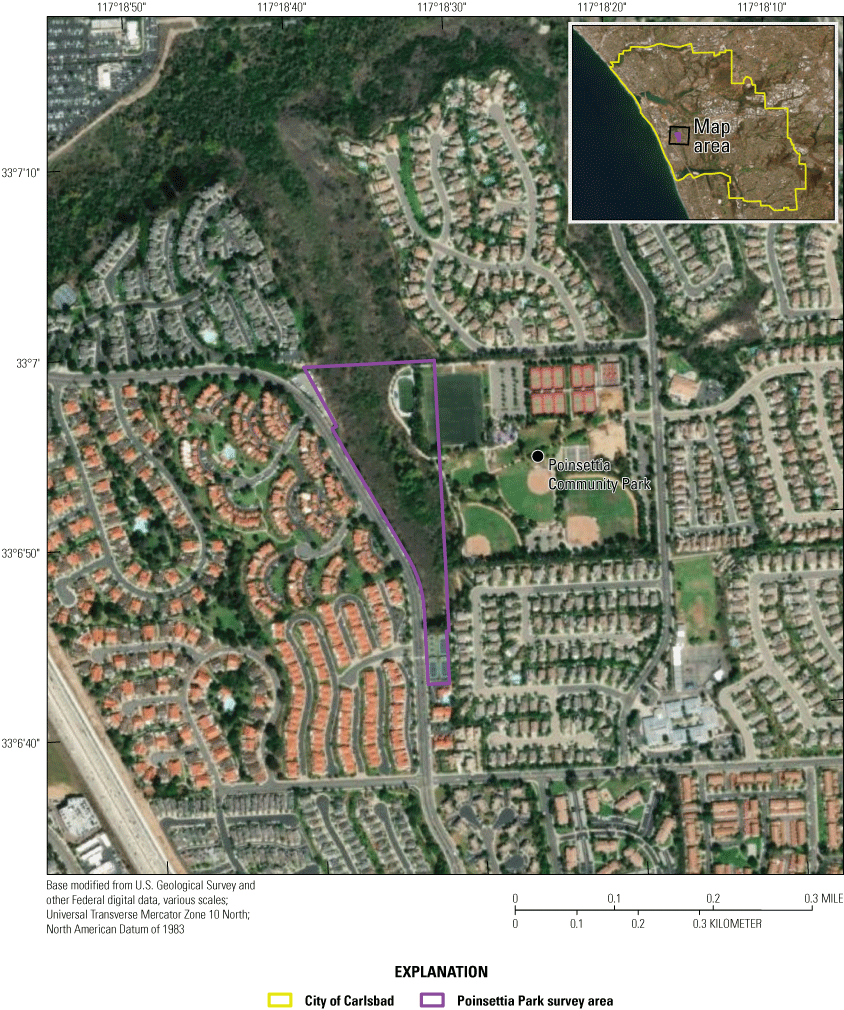
Figure 4. Southwestern Willow Flycatcher (Empidonax traillii extimus) survey area at Poinsettia Park, City of Carlsbad Preserve, San Diego County, California, 2022.
-
(4) Lagoon Lane: The Lagoon Lane survey area is a 1.1-ha patch of habitat in the central part of the Preserve and is surrounded by residential development (fig. 5). Riparian vegetation consists of small patches of willow species bordered by ornamental and coastal sage scrub species.
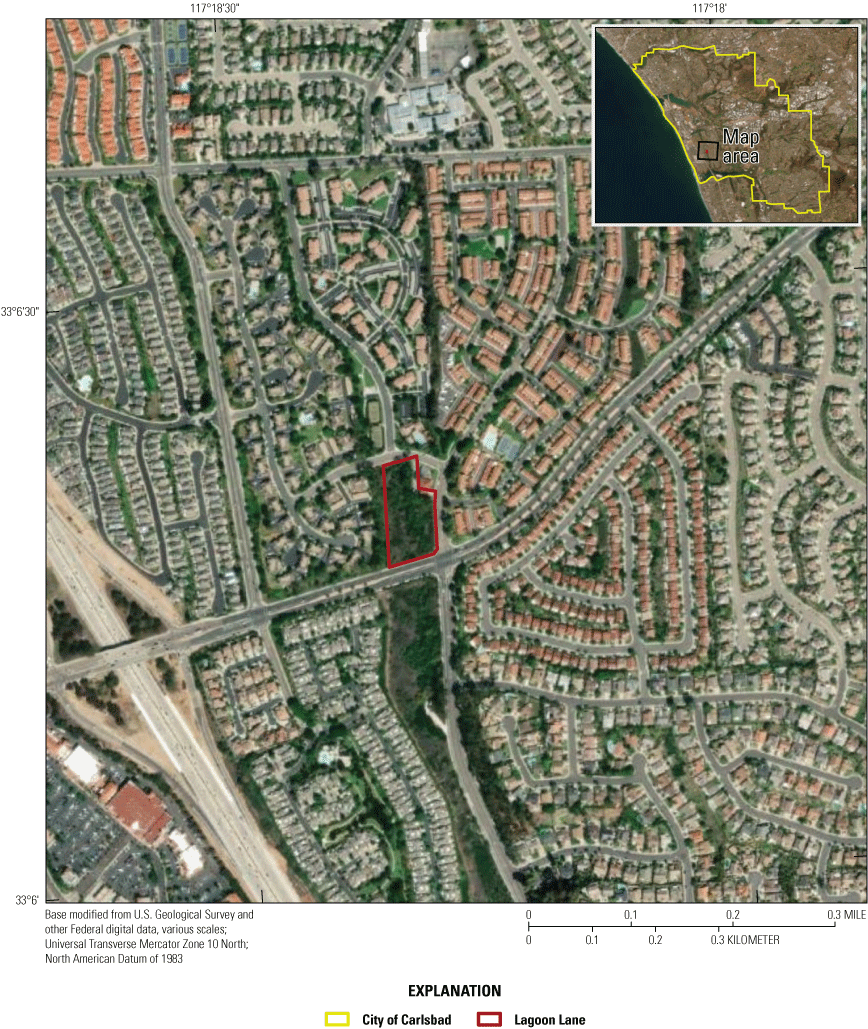
Figure 5. Southwestern Willow Flycatcher (Empidonax traillii extimus) survey area at Lagoon Lane, City of Carlsbad Preserve, San Diego County, California, 2022.
-
(5) Carrillo Ranch: The Carrillo Ranch survey area is in the easternmost part of the Preserve (fig. 6). The area surveyed includes a small tributary of San Marcos creek along the northern edge. The dominant riparian vegetation is coast live oak and California sycamore, with a sparse understory of mule fat and willow species. Small areas of ponded water and saturated soil were present throughout the survey area.
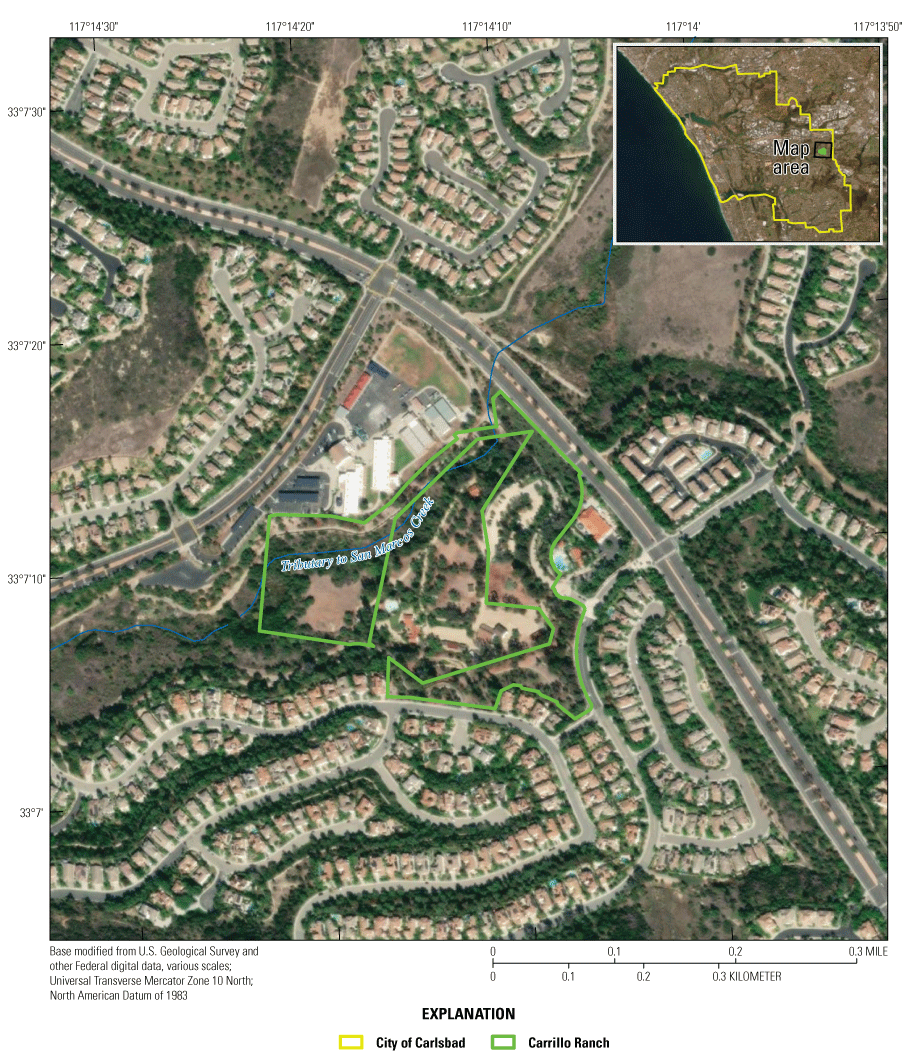
Southwestern Willow Flycatcher (Empidonax traillii extimus) survey area at Carrillo Ranch, City of Carlsbad Preserve, San Diego County, California, 2022.
Summary
Flycatchers were not detected in any of the five survey areas at the City of Carlsbad Preserve in 2022. However, the Lake Calavera and Municipal Golf Course sites support some suitable habitat, and water was present at both survey areas for the survey period. The vegetation at Poinsettia Park, Lagoon Lane, and Carrillo Ranch was limited and likely does not provide suitable breeding habitat for flycatchers. However, the vegetation may provide stopover habitat for migrating flycatchers.
References Cited
City of Carlsbad, 1999, Habitat management plan for natural communities in the city of Carlsbad: Carlsbad, Calif., City of Carlsbad, 284 p., accessed September 23, 2022, at https://carlsbadca.prod.govaccess.org/home/showdocument?id=1600.
Howell, S.L., and Kus, B.E., 2022, Distribution and abundance of Southwestern Willow Flycatchers (Empidonax traillii extimus) on the Upper San Luis Rey River, San Diego County, California—2021 data summary: Data Report 1158, 11 p., accessed September 19, 2022, at https://doi.org/10.3133/dr1158.
Schlorff, R.W., 1990, Report to the Fish and Game Commission—Status review of the Willow Flycatcher (Empidonax traillii) in California: State of California, The Resources Agency, Department of Fish and Game, Wildlife Management Division, Department Candidate Species Status Report 90-04, 23 p., accessed September 26, 2022, at https://nrm.dfg.ca.gov/FileHandler.ashx?DocumentID=22572.
Sogge, M.K., Ahlers, D., and Sferra, S.J., 2010, A natural history summary and survey protocol for the Southwestern Willow Flycatcher: U.S. Geological Survey Techniques and Methods, book 2, chap. A10, 38 p., accessed May 4, 2022, at https://pubs.usgs.gov/tm/tm2a10/.
Sogge, M.K., and Marshall, R.M., 2000, A survey of current breeding habitats, chap. 5 of Finch, D.M., and Stoleson, S.H., eds., Status, ecology, and conservation of the Southwestern Willow Flycatcher: Albuquerque, N. Mex., U.S. Department of Agriculture Forest Service, Rocky Mountain Research Station General Technical Report RMRS-GTR-60, p. 43–56.
For more information concerning the research in this report, contact the
Director, Western Ecological Research Center
U.S. Geological Survey
3020 State University Drive East
Sacramento, California 95819
https://www.usgs.gov/centers/werc
Publishing support provided by the U.S. Geological Survey
Science Publishing Network, Sacramento Publishing Service Center
Disclaimers
Any use of trade, firm, or product names is for descriptive purposes only and does not imply endorsement by the U.S. Government.
Although this information product, for the most part, is in the public domain, it also may contain copyrighted materials as noted in the text. Permission to reproduce copyrighted items must be secured from the copyright owner.
Suggested Citation
Allen, L.D., and Kus, B.E., 2023, Southwestern Willow Flycatcher (Empidonax traillii extimus) surveys at the city of Carlsbad Preserve, San Diego County, California—2022 data summary: U.S. Geological Survey Data Report 1172, 9 p., https://doi.org/10.3133/dr1172.
ISSN: 2771-9448 (online)
Study Area
| Publication type | Report |
|---|---|
| Publication Subtype | USGS Numbered Series |
| Title | Southwestern Willow Flycatcher (Empidonax traillii extimus) surveys at the city of Carlsbad Preserve, San Diego County, California—2022 data summary |
| Series title | Data Report |
| Series number | 1172 |
| DOI | 10.3133/dr1172 |
| Publication Date | May 31, 2023 |
| Year Published | 2023 |
| Language | English |
| Publisher | U.S. Geological Survey |
| Publisher location | Reston, VA |
| Contributing office(s) | Western Ecological Research Center |
| Description | v, 9 p. |
| Country | United States |
| State | California |
| County | San Diego County |
| City | Carlsbad |
| Online Only (Y/N) | Y |


